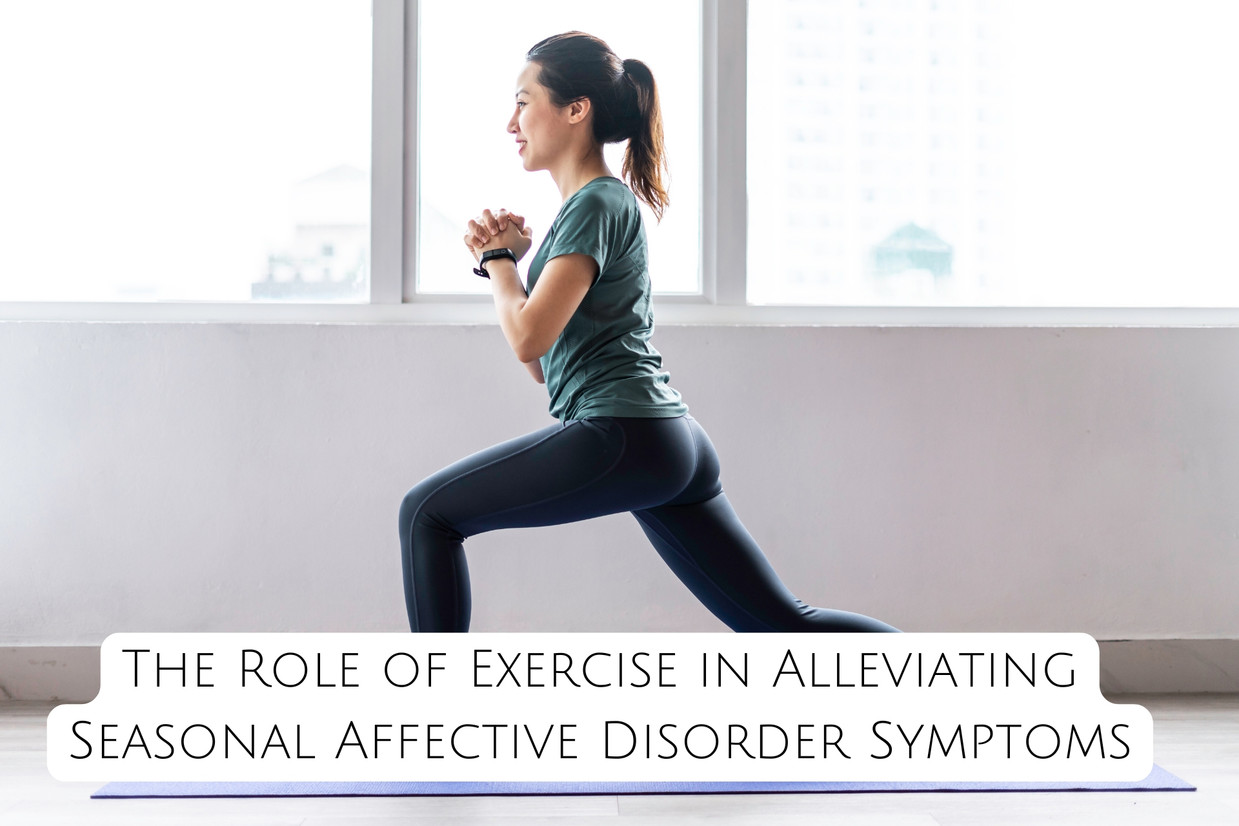The Role of Exercise in Alleviating Seasonal Affective Disorder Symptoms
Seasonal Affective Disorder (SAD) is a type of depression that occurs at a specific time each year, typically during the fall and winter months, when there is less sunlight. While the exact cause of SAD remains unclear, it is believed that the reduced exposure to sunlight during the darker months leads to changes in the brain’s neurotransmitter systems, particularly serotonin and melatonin, which affect mood and sleep.
Fortunately, there are various strategies to manage the symptoms of SAD, and one of the most effective and accessible treatments is exercise. Regular physical activity has been shown to have a significant positive impact on mental health, and for individuals with SAD, exercise can play a crucial role in alleviating symptoms and improving overall well-being.
How Exercise Helps Alleviate SAD Symptoms:
1. Boosting Mood Through Endorphins:
Exercise is well-known for triggering the release of endorphins, the body’s natural “feel-good” hormones. These chemicals help alleviate pain and stress, promoting a sense of happiness and euphoria. For individuals experiencing the low moods associated with SAD, regular physical activity helps counteract feelings of sadness, providing a natural and effective mood boost.
2. Increasing Serotonin Levels
During the winter months, when sunlight is limited, serotonin production can decrease, contributing to the symptoms of SAD. Exercise, particularly aerobic activities like walking, running, or cycling, has been shown to increase the production of serotonin in the brain. Regular exercise helps balance serotonin levels, providing a stabilizing effect on mood and reducing feelings of depression.
Exercise promotes better sleep by regulating the body’s circadian rhythm, the internal clock that controls sleep-wake cycles. Physical activity helps individuals fall asleep more easily and experience deeper, more restorative sleep. For those with SAD, improving sleep quality is essential in reducing overall depressive symptoms and enhancing daily functioning.
3. Reducing Stress and Anxiety:
Exercise is a powerful tool for reducing stress and anxiety, which are often exacerbated by the depressive symptoms of SAD. Physical activity triggers the release of neurotransmitters like dopamine and norepinephrine, which help manage stress responses and improve cognitive function. Additionally, regular exercise has been shown to reduce levels of the stress hormone cortisol, leading to an overall reduction in anxiety.
4. Increasing Vitamin D Exposure:
One of the potential contributors to SAD is a deficiency in Vitamin D, which is synthesized by the body when exposed to sunlight. Exercise, particularly outdoor activities like hiking, walking, or cycling, provides an opportunity to increase exposure to natural sunlight, thereby boosting Vitamin D levels. This can improve mood and help mitigate some of the symptoms of SAD.
Exercise, particularly when set as a regular routine, offers individuals a sense of accomplishment and control over their health. Even small milestones, like completing a short walk or attending a fitness class, can provide a sense of success and improvement. This sense of achievement can directly counteract the feelings of helplessness and stagnation associated with SAD.
Types of Exercise Effective for SAD:
While any form of exercise can be beneficial for individuals with SAD, certain types of physical activity may be particularly effective at alleviating symptoms:
1. Aerobic Exercise (Cardio):
Aerobic exercises such as running, swimming, cycling, or dancing are excellent for boosting serotonin levels, improving cardiovascular health, and increasing energy. These exercises promote the release of endorphins, which can directly combat feelings of sadness and fatigue.
2. Strength Training:
Strength training, including weight lifting and bodyweight exercises, can help individuals with SAD feel stronger and more empowered. These activities promote a sense of control over the body and can enhance mood through the release of dopamine and endorphins.
3. Yoga and Mindfulness-Based Exercise:
Yoga, tai chi, and other mindfulness-based exercises combine physical movement with deep breathing and relaxation. These practices have been shown to reduce stress, improve mental clarity, and promote emotional well-being. The mindful aspect of these exercises helps individuals connect with their bodies and reduce the negative thought patterns associated with depression.
4. Outdoor Exercise:
As mentioned, outdoor exercise provides the added benefit of exposure to sunlight, which can help combat Vitamin D deficiency and improve mood. Activities like hiking, jogging in the park, or simply walking outside are especially beneficial during the darker months, providing both the physical benefits of exercise and the emotional lift of being in natural light.
5. Group Exercise Classes:
Group fitness classes, such as cycling, aerobics, or dance classes, can provide a sense of community and connection, which is especially helpful for individuals struggling with the isolation that often accompanies SAD. The social aspect of group exercise offers an opportunity for individuals to interact with others, boosting feelings of support and camaraderie.
Creating an Exercise Plan for SAD:
When developing an exercise routine to combat SAD, it’s important to focus on consistency, enjoyment, and balance. Here are a few tips for getting started:
- Start Small: If you’re new to exercise or feeling particularly fatigued, start with shorter sessions (10–15 minutes) and gradually increase the intensity and duration as you feel more comfortable.
- Whether it’s walking in the park, cycling, or taking a dance class, finding a form of exercise you love will make it easier to stick to a routine.
- Incorporate Outdoor Activities: Whenever possible, exercise outdoors to take advantage of natural light. This is particularly helpful during the winter months when daylight hours are shorter.
- Set Realistic Goals: Set small, achievable goals for yourself, such as exercising for 30 minutes a few times a week. Gradually increase your goals as you progress.
- Consider Group Classes or a Workout Buddy: Exercising with a friend or attending group classes can increase motivation and accountability, while also providing social support.
Additional Tips for Managing SAD:
In addition to exercise, there are several other strategies that can help alleviate the symptoms of SAD:
- Light Therapy: Using a light box that mimics natural sunlight can help regulate your circadian rhythm and boost serotonin levels.
- Diet and Nutrition: A balanced diet rich in omega-3 fatty acids, whole grains, and vegetables can support brain health and improve mood.
- Therapy and Counseling: Cognitive behavioral therapy (CBT) and other therapeutic approaches can help address negative thought patterns and provide coping strategies for managing SAD.
- Vitamin D Supplements: If you live in a region with limited sunlight, talk to your doctor about taking a Vitamin D supplement to help boost your levels.
Conclusion:
Exercise plays a critical role in managing and alleviating the symptoms of Seasonal Affective Disorder. By boosting mood, improving sleep, reducing stress, and enhancing overall well-being, physical activity offers both immediate and long-term benefits for those suffering from SAD. Incorporating regular exercise into your routine, especially in outdoor settings, can help you feel more energized, focused, and positive, providing an essential tool in the fight against seasonal depression. With the right exercise plan, you can significantly reduce the impact of SAD and reclaim your mental and emotional health during the darker months.
Recent Posts
-
What Are Biofilms and Why Are They So Hard to Get Rid Of?
Biofilms are fascinating yet challenging structures that have significant implications for health, i
-
The Science Behind Boswellia Extract: How It Works in the Body
Boswellia serrata, also known as frankincense, is a resin obtained from the Boswellia tree that has
-
The Role of Un-Natured Protein in Enhancing Detoxification
While the human body is well-equipped with a detoxification system—primarily managed by the liver, k





